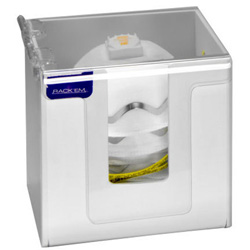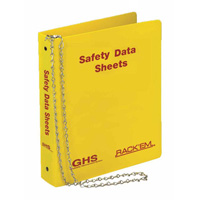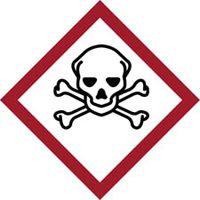| The Home page of ILPI's Safety Data Sheet (SDS) Resource, the leader in SDS information since 1995! | |
| The history and philosophy behind this resource. | |
| A curated collection of books and reference materials concerning Safety Data Sheets and closely related topics. | |
| Paste your plain text SDS into the SDS-Demystifier, and it will be converted into a hypertext-enriched document with links to detailed explanations of each key term. | |
| An extensive list of frequently asked questions about Safety Data Sheets including regulations, content, compliance, and more. | |
| A humorous take on Safety Data Sheet jargon. Fill in the blanks on our entry form to generate a personalized Unsafety Data Sheet to share with your coworkers. | |
| Since 1995, we've maintained this massive curated list of the best places to find Safety Data Sheets on the Internet. | |
| Way more than a glossary, this hypertext-enhanced resource covers hundreds of SDS-related terms and expert knowledge. Each entry includes both the SDS relevance and links to additional authoritative resources. | |
| Archived results of Safety Data Sheet related polls taken by some of our millions of site visitors | |
| You are here! The OSHA regulations behind SDS regulations, including the inspection guidelines and over 400 official interpretations letters under the Hazard Communication Standard | |
| Commercial suppliers of SDS authoring and management software as well as cloud compliance services. | |
| Commercial companies that will create SDS's for your specific needs as well as SDS translation companies. |

Safety signs, banners, and scoreboards? Get yours at Safety Emporium!
| Title: 03/25/2013 - Request for Interpretation of OSHA's Hazard Communication Standard for Combustible Dust | |
| Record Type: Interpretation | Standard Number: 1910.1200 |
March 25, 2013
Jonathan L. Snare
Morgan, Lewis & Bockius LLP
1111 Pennsylvania Avenue, NW
Washington, DC 20004
Re: Request for Interpretation of OSHAs Hazard Communication Standard for Combustible Dust
Dear Mr. Snare:
This is in response to your inquiry on behalf of the American Chemistry Council concerning how OSHA's March 26, 2012, revisions to its Hazard Communication Standard (HCS 2012 ) apply to combustible dust. Below I summarize each of your questions and provide our response to it.
- Hazard Statement. Under HCS 2012 , chemicals that have been classified as combustible dusts must include the following hazard statement on their labels and safety data sheets (SDSs): "May form combustible dust concentrations in air." You ask whether, for chemicals that pose a combustible dust hazard when processed but not in the current shipped form, the responsible party1 may include additional language with the hazard statement. You propose two alternatives (indicated by italics):
- If converted to small particles during further processing, handling, or by other means, may form combustible dust concentrations in air.
- If small particles are generated during further processing, handling or by other means, may form combustible dust concentrations in air.
- If converted to small particles during further processing, handling, or by other means, may form combustible dust concentrations in air.
OSHA RESPONSE: Paragraph C.3.1 of Appendix C to HCS 2012 states that the responsible party may provide additional information on a label "when it provides further detail and does not contradict or cast doubt on the validity of the standardized hazard information." OSHA views either of the alternatives you propose as falling within C.3.1 because they provide additional detail and do not contradict or cast doubt on the validity of the required hazard statement where the chemical does not present a combustible dust hazard in the form shipped. Similarly, the required elements listed in Appendix D for SDSs are the minimum information required and OSHA believes that additional information that satisfies C.3.1 may be included in Section 2 of the SDS if the additional information concerns hazard identification. Therefore, it would be acceptable to OSHA if responsible parties included either alternative in conjunction with the required hazard statement on labels and SDSs for such chemicals.
- Safety Data Sheets. Your two questions on SDSs also pertain to chemicals that are not a combustible dust in the form shipped but that may present a combustible dust hazard under normal conditions of use due to the way they are processed by a downstream user.
- You ask whether SDSs may include additional information and explanatory statements, and provided us with a hypothetical SDS containing such information. In general, OSHA does not offer letters of interpretation passing on the adequacy of particular SDSs because OSHA does not possess the manufacturers' knowledge about the hazards and use of the product. OSHA is not making a determination on the adequacy of the hypothetical SDS you provided, however, there are a few general issues presented that OSHA can provide an interpretation on.
In Section 2 (Hazard Identification) of the SDS, you propose listing:
- "OSHA Hazard Category: combustible Dust";
- "GHS Hazard Categories: Not classified";
- "OSHA label elements," including the fact that there is no pictogram, a signal word of "Warning," the hazard statement for combustible dust with the additional language noted above in 1.b., and certain precautionary statements about the combustible dust hazard;
- Information about any hazards not otherwise classified presented by the product; and
- HMIS and NFPA ratings for the product.
- "OSHA Hazard Category: combustible Dust";
- You ask whether SDSs may include additional information and explanatory statements, and provided us with a hypothetical SDS containing such information. In general, OSHA does not offer letters of interpretation passing on the adequacy of particular SDSs because OSHA does not possess the manufacturers' knowledge about the hazards and use of the product. OSHA is not making a determination on the adequacy of the hypothetical SDS you provided, however, there are a few general issues presented that OSHA can provide an interpretation on.
OSHA RESPONSE: For purposes of this response, OSHA assumes that the SDS is for a chemical that poses a combustible dust hazard arising from downstream processing, but not in the shipped form, and that it presents no other HCS-covered hazards. In such cases, OSHA views the language in items (i) and (ii) above as being consistent with the requirements of Section 2(a) of Appendix D of HCS 2012 .
For item (iii), it is consistent with Section 2(b) of Appendix D to note that there is no pictogram and to use the same additional language that appears on the label in conjunction with the required hazard warning language. The signal word "Warning" is also required. OSHA has no required precautionary statements for combustible dust, and therefore none are required in Section 2 of the SDS. Responsible parties may add their own precautionary statements to Section 2 so long as they are relevant and do not contradict or cast doubt on the validity of the other information in the SDS.
The information referenced in item (iv) is required by Section 2(c) of Appendix D. On item (v), responsible parties may include HMIS and NFPA ratings in Section 2 of the SDS as long as they do not contradict or cast doubt on the HCS 2012 classification.
- Appendix C.4.30, footnote 2, states that where chemicals are not shipped in a dust form but may be processed under normal conditions of use by a downstream user in such a way as to create a combustible dust hazard, the responsible party may provide labels in accordance with 1910.1200(f)(4). That provision allows labels to be provided once to downstream users, either with the initial shipment or with the SDS for the chemical. You ask whether it would be acceptable to provide the (f)(4) label by printing it at the top of the first page of the SDS.
OSHA RESPONSE: Yes, where (f)(4) applies, it is acceptable to provide the label by printing it at the top of the first page of the SDS. Note that the (f)(4) partial labeling exemption is available only for chemicals that present no HCS 2012-covered hazard in the form shipped. If a chemical presents an HCS 2012-covered hazard in the form shipped, for example a health hazard, the (f)(4) exemption would not apply even if the chemical presents a combustible dust hazard only after processing in the normal conditions of use.
- Labels on shipped containers. You have several questions concerning the labeling of chemicals presenting a combustible dust hazard.
- You ask whether it is acceptable for a shipped container containing a chemical that presents a combustible dust hazard to include an HMIS label in addition to the information required by 1910.1200(f)(1) and C.4.30.
OSHA RESPONSE: Yes, so long as the ratings in the HMIS label do not contradict or cast doubt on the validity of label information required by HCS 2012 (C.3.1) or impede the user's ability to identify the information required by HCS 2012 (C.3.2).
- You also ask whether, when (f)(4) applies, the shipped container may bear a label containing only product identifiers, manufacturer name and address, and an emergency phone number. In addition, you ask whether, in addition to the information contained in the previous sentence, the container may also bear an HMIS label.
OSHA RESPONSE: Yes, where (f)(4) applies and the HCS 2012 label has already been provided by other means, either of these alternatives are acceptable. In fact, OSHA encourages responsible parties to provide product identifier and contact information on each shipped product whenever they take advantage of the (f)(4) option. However, any information that appears may not contradict or cast doubt on the validity of the label information required by HCS 2012
- Finally, you ask whether, under footnote 2 to C.4.30, the (f)(4) partial labeling exemption is available for a liquid that under normal conditions of use may turn into a solid form that presents a combustible dust hazard.
OSHA RESPONSE: Yes, assuming the liquid in its shipped form presents no other hazard that would be classified under HCS 2012 . As discussed in 2.b, if the liquid presents any other hazards, then (f)(4) would not apply. Again, OSHA encourages responsible parties to provide the product identifier and contact information on each such product.
- Workplace labels. This issue concerns the workplace labeling requirements under 1910.1200(f)(6) in situations where a chemical is not a combustible dust in the form shipped, but may become one when processed by a downstream user. Your first question is whether, when the responsible party provides the label in accordance with (f)(4), the downstream user must label any containers containing the chemical in the workplace. Second, you ask if whether, once the product is processed in a way to create the combustible dust hazard, the employer may warn of the hazard by labeling the area (consistent with 1910.1200(f)(7)) where the processing of the materials generates sufficient dust to present a combustible dust hazard in lieu of affixing an (f)(1) label to each container. Finally, if the materials are not in a "container," as defined in 1910.1200(c), but the processing of the materials (e.g., the sawing of PVC pipes or lumber) is such that it may create a potential combustible dust hazard, you ask whether the employer may warn of the hazard by labeling the work areas (consistent with 1910.1200(f)(7)) where the processing of the materials takes place in lieu of affixing an (f)(6) label on each piece of piping or lumber.
OSHA RESPONSE: This response assumes the only HCS 2012-covered hazard presented by the chemical is that related to combustible dust. On your first question, the workplace labeling requirement would begin only once the chemical is brought into the work area where it will be processed in a way to create the combustible dust hazard. On your second question, 1910.1200(f)(7) states that for stationary process containers, the employer may use signs or placards as long as the alternative method identifies the containers to which it is applicable and conveys the information required by paragraph (f)(6) of this section to be on the label.
Thus, for stationary process containers, so long as the signs or placards used in your scenario are easily visible to the employees in the work area, convey the information required by (f)(6), and identify the containers to which they are applicable, the employer's workplace labeling obligation for the chemical would be satisfied. Other containers must bear the information specified in (f)(6). At a minimum, (f)(6) requires the product identifier and words, pictures and/or symbols that provide general information of the hazard, and in conjunction with other information immediately available to the employees, provides employees with the specific information about the combustible dust hazard.
Finally, the workplace labeling requirements in (f)(6) apply only to chemicals that are in containers. Thus, individual boards or pipes that might create a combustible dust hazard when cut do not need to be labeled under (f)(6). It is permissible (and OSHA encourages) the use of signs or placards to advise workers of the hazard in such circumstances, but signs and placards are not required.
Of course, the employer has other responsibilities under HCS 2012 for these products as well, including training, maintaining SDSs, and providing SDSs to employees in an easily accessible manner.
Thank you for your interest in occupational safety and health. We hope you find this information helpful. OSHA requirements are set by statute, standards, and regulations. Our interpretation letters explain these requirements and how they apply to particular circumstances, but they cannot create additional employer obligations. This letter constitutes OSHA's interpretation of the requirements discussed. Note that our enforcement guidance may be affected by changes to OSHA rules.
Sincerely,
David Michaels, Ph.D, MPH
Assistant Secretary of Labor for
Occupational Safety and Health
cc. Leslie A. Hulse, Esq.
American Chemistry Council
1 In this letter, the term "responsible party" refers to a person required by HCS 2012 to provide labels and SDSs to downstream users.
The original official public domain version of this document is available from OSHA at https://www.osha.gov/laws-regs/standardinterpretations/2013-03-25.



